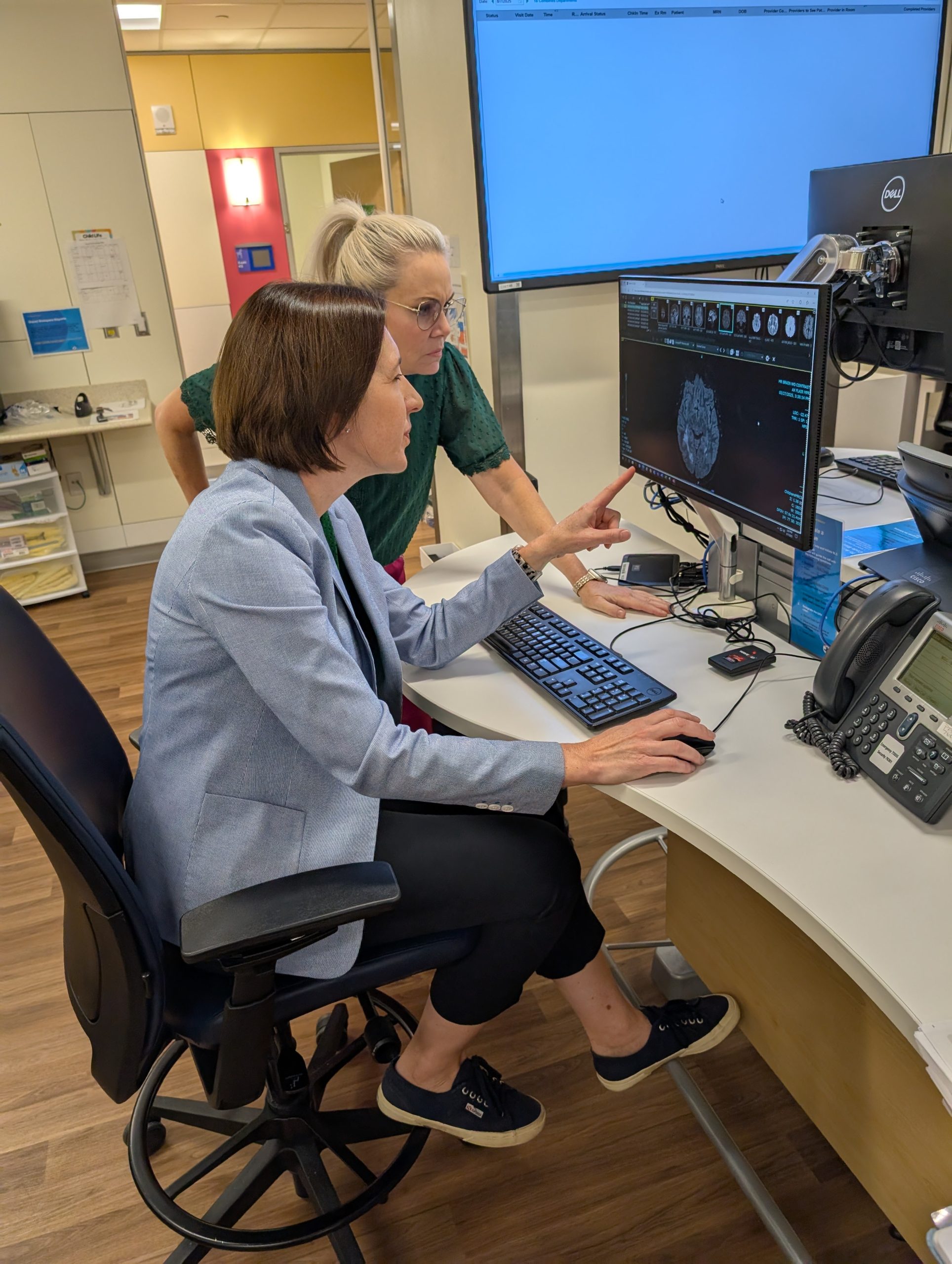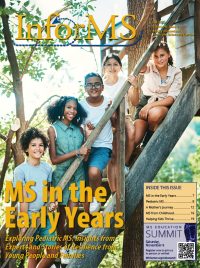
For most families, multiple sclerosis is something they associate with adulthood. But MS can also affect children and teens—and while uncommon, the impact can be profound. Pediatric MS is highly inflammatory, often more active than in adults, and comes at a time when children are still growing, developing, and building their independence
To help families and the MS community understand this complex topic, we sat down with the Rocky Mountain MS Center’s Dr. Teri Schreiner, who also serves as Director of the Neuroimmunology Clinic for Children (NICC) at Children’s Hospital Colorado. She shares the latest insights into diagnosis, treatment, and research, along with guidance for families navigating this rare but important diagnosis.
InforMS: Can you tell us what we currently know about pediatric MS? Feel free to take a broad approach.
Dr. Teri Schreiner: I’m excited to say that we’ve learned quite a lot about the onset of multiple sclerosis in patients younger than 18 years over the past decade or so.
One of the key insights is that while the clinical presentation in children can differ from adults, the underlying biology of the disease is largely the same. So, pediatric MS is not a separate disease process, but rather the same disease manifesting earlier in life.
We know that MS can occur in prepubertal children, under 12 years old, but that’s quite rare. As children age into adolescence, the incidence of MS increases.
Importantly, pediatric MS tends to be highly inflammatory. For comparison, while an untreated adult might have one relapse every two years, a child might experience two to three relapses in a single year. That level of disease activity is significant and underscores the need for timely and effective treatment.
Another interesting aspect is how sex differences shift with age. In younger children, MS is slightly more common in boys. But by adolescence, the ratio starts to mirror that of adults—about two girls for every one boy diagnosed.
“Our goal is not just to treat MS, but to help people live their fullest lives with it.”— Dr. Schreiner
InforMS: Have there been any important developments recently in terms of risk factors or causes?
Dr. Schreiner: Yes, several. We’ve gained a better understanding of what we call modifiable risk factors, meaning the things we may be able to change to reduce MS risk. For example: Children exposed to secondhand smoke are at increased risk; low vitamin D levels are associated with higher MS risk; childhood obesity also appears to be a contributing factor; additionally, living in areas with lower sun exposure, and thus lower natural vitamin D, seems to play a role.
These modifiable factors give us a powerful opportunity to potentially change a child’s risk profile with relatively simple lifestyle or environmental interventions.
InforMS: What does the current treatment landscape look like for pediatric MS, and are there any exciting new approaches emerging?
Dr. Schreiner: We know that the early use of high-efficacy therapies can make a significant difference, just as it does in adults. Starting a highly efficacious medicine right after diagnosis helps preserve neurological function and reduces the risk of long-term disability. That’s why our approach at RMMSC is to begin treatment with high-efficacy medications from the outset.
The most commonly used therapy in our clinic is rituximab, an intravenous medication given every six months that works by depleting B cells, which are immune cells that play a key role in MS. This strategy has proven highly effective in preventing relapses in many of our young patients.
We’re also involved in clinical trials studying ocrelizumab (Ocrevus), another B cell-depleting therapy already approved for adult MS. Early results from phase 2 trials in children are very promising. The drug appears to work in kids just as it does in adults, reinforcing the idea that MS disease biology is consistent across age groups. We’ve also been able to determine safe and effective dosing for pediatric patients, which is critical. Our hope is that these studies will lead to FDA-approved therapies specifically for children, rather than relying on data extrapolated from adults.
In addition to B-cell therapies, there are other promising medications on the horizon, including ofatumumab (Kesimpta) and ublituximab (Briumvi)—both targeting B cells with different delivery methods. We’re also using natalizumab (Tysabri), a highly effective monthly infusion with a different mechanism of action that’s well-suited for some patients.
For those who prefer not to receive infusions, oral medications like fingolimod (Gilenya) offer another option. While these drugs tend to be somewhat less effective, they can still help—especially for patients who are needle-averse. The main challenge with oral treatments is adherence. I always remind families: no medication works if you don’t take it. Daily or twice-daily pills require a level of consistency that can be tough for kids and teens, so we work closely with families to find a treatment plan that fits their needs and lifestyle.
InforMS: Let’s talk a little bit more about treatment adherence. Can you speak to the importance of sticking with prescribed medication, and what some of the challenges are—particularly for pediatric MS patients?
Dr. Schreiner: Absolutely. Adherence can be really challenging in pediatric MS. When a young child is diagnosed, it’s usually the parents who handle everything—scheduling infusions and/or taking oral medicines, managing lab work, and keeping track of appointments. But as kids grow into adolescence, there’s a natural push toward independence. That can be difficult when managing a chronic disease like MS becomes part of their personal responsibility.
We work hard to empower our adolescent patients to start taking ownership by making their own appointments, ensuring labs get done, refilling medications and messaging me when issues arise. But executive function is still developing at that age, and medication adherence can slip through the cracks, especially with oral or injectable medications that require regular self-management.
With infused medications, adherence tends to be better because they’re scheduled and administered in a clinic, and we’re able to monitor whether patients are receiving them. Still, it’s not perfect. We can’t enforce adherence, so we focus on education and gradually building independence. Our goal is for patients to leave home knowing what they need to do to stay well and having the tools to follow through.
InforMS: You mentioned earlier that obesity in childhood may increase the risk of developing MS. Can you expand on that?
Dr. Schreiner: Yes, we’ve found that obesity in childhood can increase the risk of developing MS by about twofold. That doesn’t mean every child with obesity will develop MS, but rather it suggests a significant correlation.
We believe this may be because fat tissue is pro-inflammatory. It can contribute to a general increase in inflammation throughout the body, which may, in turn, increase susceptibility to autoimmune diseases like MS. It’s one of the several modifiable risk factors we’re paying close attention to.
“Every patient’s MS is different. Listening carefully is the first step to providing the right care.”— Dr. Schreiner
InforMS: What symptoms are most common when kids first show up to a health care provider?
Dr. Schreiner: The first attack of MS in a child often includes more than one symptom. For example, they may have balance issues, difficulty walking, weakness in one or more limbs, numbness, and/or coordination problems. They might also have issues with eye movements or functions related to the lower brainstem.
Like adults, a common presentation is optic neuritis, or vision loss in one eye. But kids can also present with more varied and widespread symptoms than adults typically do.
InforMS: When a child presents with these kinds of symptoms, where do they usually go first?
Dr. Schreiner: Most often, they’ll be seen first in the emergency department or by their primary care provider. Sometimes the pathway to diagnosis is direct – they’ll be referred for an MRI, possibly a lumbar puncture, and more comprehensive neurologic testing.
But MS is still relatively rare in kids, so it’s not always top of mind for providers. As a result, some families may first see an optometrist, ophthalmologist, or other specialists before the child makes it to a pediatric neurologist.
InforMS: How rare is pediatric MS compared to adult MS?
Dr. Schreiner: It’s quite rare. Only about 5% of all MS cases in the U.S. are diagnosed in individuals under the age of 18. That rarity is part of what makes early recognition and diagnosis so challenging.
InforMS: Given how rare it is, what are the biggest challenges in diagnosing MS in children?
Dr. Schreiner: One big challenge is simply awareness. MS often isn’t on the radar for general providers. We’re working hard to change that through education and outreach.
Another major challenge is that there are several other diseases that can mimic MS, especially in the early stages. When a child presents with neurologic symptoms, we have to do a thorough workup to rule out other conditions. That includes MRI scans of the brain, spine, and sometimes the orbits (around the eyes), depending on symptoms. We also run blood tests to rule out other autoimmune or inflammatory disorders.
For example, MOGAD (Myelin Oligodendrocyte Glycoprotein-Associated Disease) can look a lot like MS, but it has a specific antibody marker in the blood. Another is neuromyelitis optica spectrum disorder (NMOSD), which also mimics MS but is associated with a different antibody—aquaporin-4.
In addition to imaging and bloodwork, we sometimes use optical coherence tomography (OCT) to check for nerve damage in the eyes. And we still occasionally perform lumbar punctures to look for oligoclonal bands, a marker in the cerebrospinal fluid that supports an MS diagnosis.
InforMS: What about lifestyle modifications—those non-medication approaches? What kinds of things do you emphasize to your pediatric patients that they can take control over in their daily lives?
Dr. Schreiner: Right from the time of diagnosis, I emphasize how important the foundational aspects of health are – things like exercise, sleep, hydration, and nutrition.
I encourage patients to exercise regularly: ideally three to five times a week, for at least 20 minutes at a time, with sustained elevated heart rate. It’s important that this becomes part of their routine, not just an occasional effort. I also talk about hydration, but in a way that’s easy to monitor. For kids, we often use urine color as a guide—if it’s yellow, they’re likely not drinking enough water.
Sleep is another big one. Getting regular, consistent sleep is crucial for brain health. That means going to bed and waking up at the same time every day. It supports memory, mood, and overall neurologic recovery.
As for nutrition, there’s no single “MS diet” I recommend. I do stress minimizing processed foods and focusing on whole, recognizable ingredients—especially vegetables and fruits. If you can’t pronounce the ingredients in your food, that’s a red flag. Eating real, unprocessed food helps support the body’s overall wellness and may reduce inflammation.

Staff and partners at the NICC take a multidisciplinary approach to the evaluation, diagnosis and care of children and teens with MS and related neuroinflammatory disorders.
InforMS: Beyond the physical symptoms, are there cognitive or developmental effects that families should be aware of in children diagnosed with MS?
Dr. Schreiner: Even early in the disease course, just a few years after diagnosis, we can see cognitive changes in children with MS. These can include challenges with executive function, divided attention, or performing tasks like math that are otherwise age appropriate. This is a really important part of the disease that can get overlooked because these kids may look physically well.
We make a point to monitor cognitive function early and regularly, and when we see areas of concern, we work with families and schools to put the right supports in place. That way, these children can achieve their full academic and developmental potential, despite their diagnosis.
InforMS: Now, let’s turn to the research side of things. Could you please talk about the RISE and DREAMS studies and what you’re currently learning?
Dr. Schreiner: At the Rocky Mountain MS Center CU, we’re conducting research to better understand MS risk in first-degree relatives of people with the disease. First-degree relatives include children, siblings, or parents of someone with MS.
Dr. John Corboy, my mentor, started the RISE MS study, which stands for “Risk Factors in Early MS.” It initially focused on people aged 18 to 30. I expanded it by launching DREAMS, which includes first-degree relatives between the ages of 10 and 17. Together, these studies cover the age range of 10 to 30 and aim to understand individual risk by looking at several key areas.
Each participant completes a comprehensive environmental questionnaire. We ask about where they grew up, exposure to smoke or toxins, family history of autoimmunity, and more. These are known risk factors for MS. Then, we perform brain MRIs, even though the first-degree relatives have no symptoms, to look for white matter changes or lesions that may suggest preclinical MS.
We also do blood tests. We look at genetic risk factors—there’s no single MS gene, but we now know there are at least 236 small genetic changes that are more common in people with MS. We also measure vitamin D, cholesterol, and markers of Epstein-Barr virus history.
Ultimately, our goal is to combine this data—MRI, genetics, environment, and blood biomarkers—to create a more accurate individual risk profile. If we can identify people at particularly high risk, we may be able to focus on preventive measures and early interventions, possibly even before the first attack.
InforMS: What have the studies shown so far? Are there early insights?
Dr. Schreiner: Yes, we’ve had some really exciting findings. We now have data from around 200 participants, and among them, we’ve identified a subset of first-degree relatives who have white matter changes on their MRI, even though they have no neurological symptoms.
We’ve also looked at their genetic profiles and found that those who have these brain lesions tend to carry more of the known MS-associated genetic variants. In other words, they genetically resemble MS patients more than people without the disease. That strengthens the case that these lesions are early indicators of MS risk.
We’re currently working on incorporating other data—body mass index, smoking history, vitamin D levels, EBV exposure, etc.—to build a comprehensive risk scoring tool. The hope is that one day, we’ll be able to give someone a detailed picture of their MS risk and, more importantly, help them take action early.
Interestingly, we’ve already diagnosed a few individuals with MS through the study. One pediatric participant had no symptoms but showed progressive MRI changes over time that were consistent with MS. In the adult cohort, one participant developed optic neuritis after MRI showed lesions, confirming the diagnosis. I believe a second adult participant has now also met diagnostic criteria.
InforMS: Are there any other important research findings that have emerged recently?
Dr. Schreiner: Yes. One particularly interesting discovery is that children who are eventually diagnosed with MS tend to have more healthcare visits in the years leading up to their diagnosis—for all kinds of reasons, not just neurological ones. This pattern mirrors what we see in adult MS and suggests that something may be happening in the body before clear MS symptoms emerge. It’s a compelling clue that we’re still exploring.
Another exciting area of research involves biomarkers, particularly neurofilament light. This is a protein that can be detected in the blood and may indicate neuronal damage in the brain. When the brain is inflamed or under attack, as occurs in MS, small amounts of this protein leak into the bloodstream. The hope is that we’ll eventually be able to use a simple blood test to monitor disease activity, reducing our reliance on frequent MRIs. While this isn’t a test that’s available for clinical use yet, it holds a lot of promise for the future.
InforMS: You’ve talked throughout about how pediatric MS care can inform adult care. Is there anything more you’d like to expand on regarding those connections?
Dr. Schreiner: One of the unique advantages of studying pediatric-onset MS is that it allows us to better isolate the environmental and biological triggers of the disease. When a child is diagnosed, they naturally have a shorter life history—less time to accumulate illnesses, viral infections, or other confounding exposures. That makes it easier to identify what may be contributing to the disease’s onset.
We’re seeing that the biology of MS likely begins well before diagnosis, even in children. One example is our research on telomere length. Telomeres are markers of biological aging, not just chronological aging. What we’ve found is that children with MS already have shorter telomeres at the time of diagnosis compared to healthy controls. That means their biology may be older than their actual age by about two years, in some cases. And since telomere length doesn’t change overnight, this suggests disease processes may begin long before symptoms appear.
Another area we’ve looked at is childhood adversity, including things like chronic illness in the family, poverty, parental divorce, or early trauma. We’ve found that pediatric MS patients report higher levels of these adverse experiences compared to their healthy peers. This points to a broader interplay between early-life stress, resilience, and biology, and helps us think more holistically about what might predispose someone to develop MS at a young age.
InforMS: We often hear from adults with MS who are concerned about their children’s risk. What is the known risk and what should parents with MS be paying attention to in their children who don’t have the disease?
Dr. Schreiner: This is a common and valid concern. The estimated risk of MS in children of people with MS is increased, but it’s still relatively low overall. In the general population, the lifetime risk of developing MS is quite small. For first-degree relatives, like children of people with MS, the lifetime risk is 7-9 times higher. But even with that increase, the majority of children of people with MS will not go on to develop the disease.
While our research is focused on understanding the risk in first-degree relatives, we’re not at a point where we recommend MRI screening or routine blood testing for children of people with MS.
What I do recommend is creating a home environment that supports overall brain and immune health. That includes: A smoke-free home; regular physical activity; a healthy, balanced diet; Vitamin D supplementation, if needed, to maintain normal levels; and strong education around avoiding tobacco and vaping, which we know are associated with increased MS risk.
These are proactive steps any family can take that are good for long-term health, regardless of MS risk.
InforMS: You’ve given us such a clear understanding of the complexities of pediatric MS. As we wrap up, what’s the key message you hope parents, caregivers, and the broader MS community take away from your experience?
Dr. Schreiner: One overarching message I want to emphasize is awareness – that MS can and does occur in children. And when it does, it comes at a particularly vulnerable time in life.
For young people, their identity is still forming, and a diagnosis like MS can feel defining. I always tell my patients that they are not their disease. They are healthy, vibrant individuals who happen to have a chronic illness that needs treatment, just like someone might need glasses or insulin.
We also need to be aware of the psychosocial impacts on the child, their siblings, and their parents. A diagnosis of MS in a child affects the whole family. That’s why integrating mental health support into care from the beginning is so critical. We want to treat the disease, of course, but we also want to help families navigate the emotional and social impacts it brings.
With early diagnosis, comprehensive care, and strong support, children with MS have every opportunity to not only manage their condition but to flourish and pursue their dreams fully.





